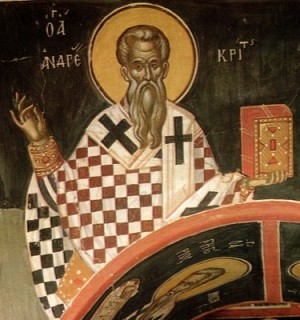The First Vigil
 The Great Canon of St Andrew of Crete
The Great Canon of St Andrew of Crete
The Great Canon of St Andrew, Bishop of Crete, also known in the Serbian Tradition as the First Vigil. This is the longest canon in all of our services, and is associated with Great Lent, since the only times it is appointed to be read in church are the first four nights of Great Lent (Clean Monday through Clean Thursday, at Great Compline, when it is serialized) and at Matins for Thursday of the fifth week of Great Lent, when it is read in its entirety (in this latter service, the entire life of St Mary of Egypt is also read).
There is no other sacred hymn which compares with this monumental work, which St Andrew wrote for his personal meditations. Nothing else has its extensive typology and mystical explanations of the scripture, from both the Old and New Testaments. One can almost consider this hymn to be a “survey of the Old and New Testament”. Its other distinguishing features are a spirit of mournful humility, hope in God, and complex and beautiful Trinitarian Doxologies and hymns to the Theotokos in each Ode.
The canon is a dialog between St. Andrew and his soul. The ongoing theme is an urgent exhortation to change one’s life. St Andrew
A canon is an ancient liturgical hymn, with a very strict format. It consists of a variable number of parts, each called an “ode”.
An “Irmos” begins each Ode. This is generally sung, and each Irmos has a reference to one of the nine biblical canticles, which are selections from the Old and New Testament. A variable number of “
The general Themes of the Great Canon are: how we should think about ourselves;
THE MOST IMPORTANT THING TO KNOW ABOUT THE GREAT CANON.
The Great Canon was written by a holy man to teach himself the right way to live. We cannot benefit from it unless we make it a priority to stand in prayer, in the church, and listen to it, with a great desire and expectation for God’s grace to teach us and heal us. Our theology is first and foremost – experienced and prayed, and not only “studied”.






